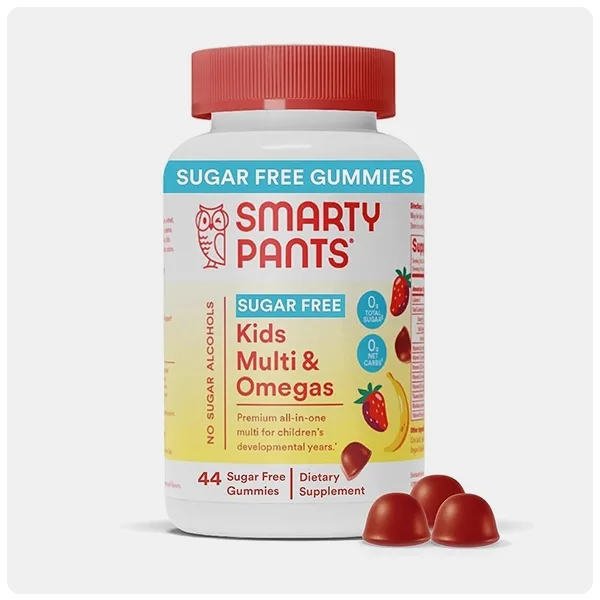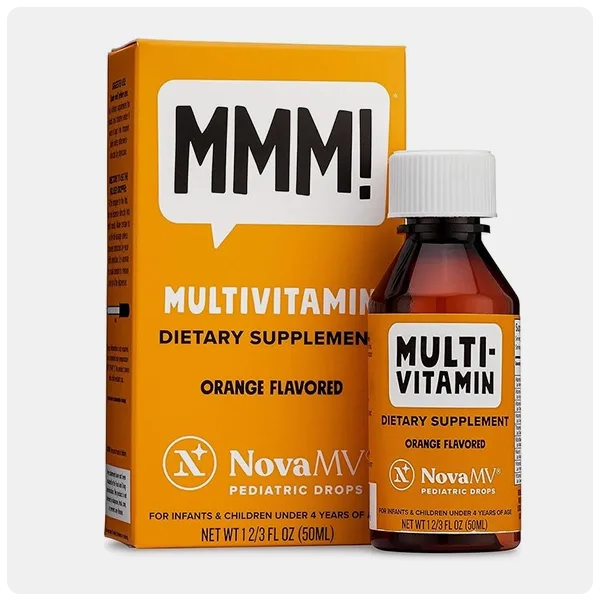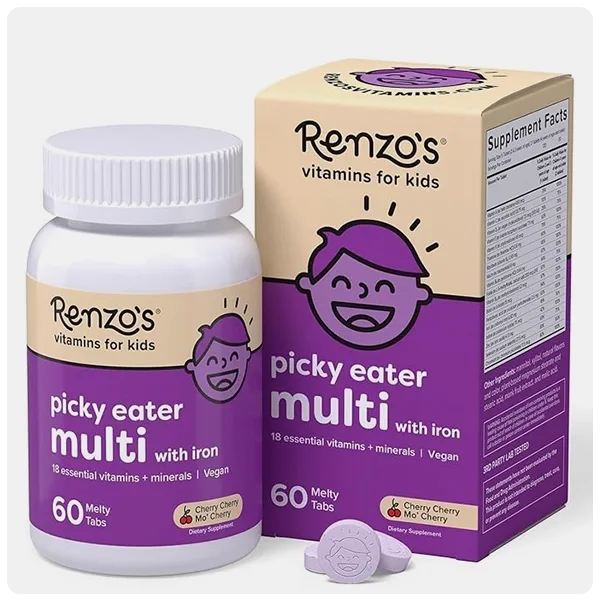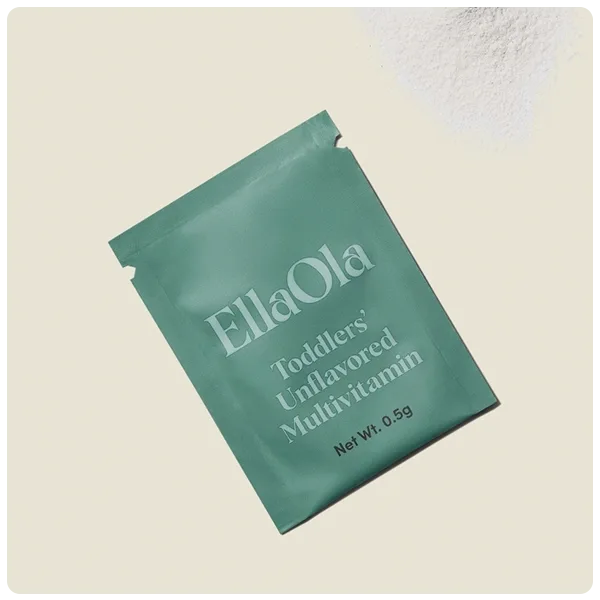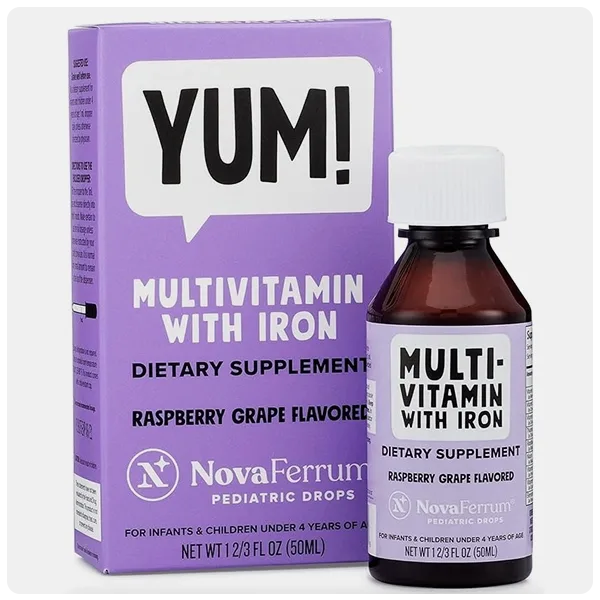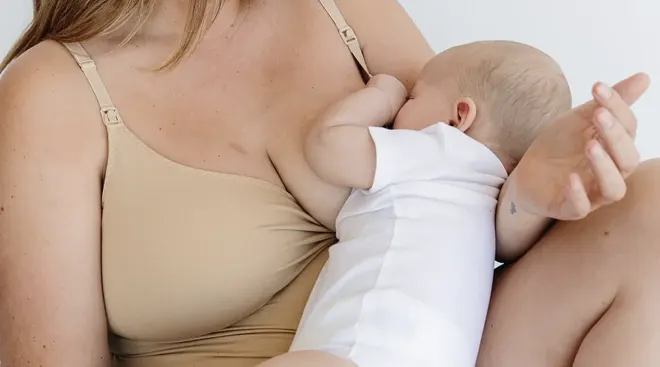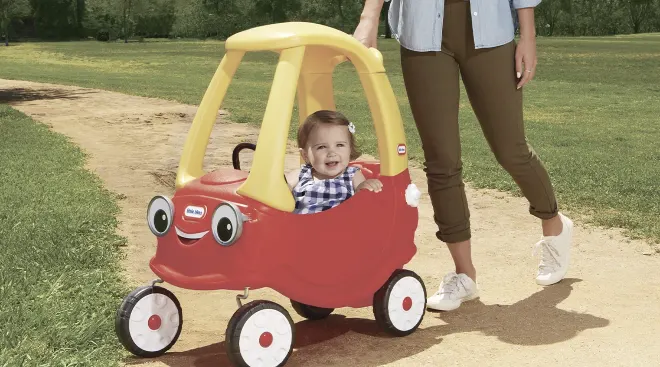Best Toddler and Kids' Vitamins, Tested by a Dietitian and Mom
In a nutshell:
Based on product testing by a pediatric dietitian and a mom, as well as expert advice from a pediatrician, we selected Smarty Pants Sugar Free Kids Multi & Omegas as the overall best multivitamin for kids age 4+, and NovaFerrum’s MMM! Multivitamin as overall best toddler multivitamin. These supplements impressed us with their exceptional taste, ease of administration, age-appropriate composition and high nutritional value.
As a pediatric dietitian and a mom of three kids under six, I’m familiar with the struggles of getting kids to eat a wide range of healthy foods. While I prefer to offer vitamins and minerals from whole foods first, let’s be real—it’s not always realistic or feasible. I experienced picky eating with two of my toddlers, one of whom practically survived on crackers and cheese quesadillas for a good six months. For picky eaters or kids with special dietary needs or restrictions, adding toddler vitamins into their routine may be just what they need. Supplementing their diet with a toddler multivitamin brings me peace of mind because I can fill in nutritional gaps and tackle deficiencies from a diet lacking certain food groups (hello, meat and veggies!).
In order to help you choose the best vitamins for kids, I’ve collected insights from our testing adventures and made suggestions based on my experience as a dietitian and mom. Below, you’ll find my top 5 recommendations for kids’ and toddler vitamins.
With dozens of multivitamins to choose from, finding the best vitamins for kids can feel overwhelming. But hey, that’s where this article comes in clutch! With the support of The Bump editorial team, I’ve done the heavy lifting, so you don’t have to. And who knows, maybe you’ll have an extra moment to sneak in a few sips of your morning coffee. Here are the steps we took to select the best vitamins for toddlers:
- I tested eight different options with the assistance of my two toddlers—aged 16 months and 3 years—who served as junior testers. Based on my experience as a pediatric dietitian and mom of three, I evaluated the ingredients list, ease of use, value for money and overall quality of the vitamins, while my kids weighed in on the scent and taste of each supplement. All of the products on this list were well-liked by our junior testers.
- We sent two different multivitamins to a third-party reviewer to test with her 4-year-old so we could match our kids’ vitamins with an appropriately aged child.
- The Bump team interviewed a board-certified pediatrician and consulted guidelines from the Academy of Nutrition and Dietetics, for more information on the nutritional needs of young children.
- We prioritized multivitamins from reputable brands that are third-party tested for quality and purity, when possible.
- We chose multivitamins that provide the appropriate doses of nutrients, aligning closely with the recommended dietary allowances (RDAs) for children aged 1 to 3 years and for children 4 years and up. We only tested products that are easy to administer and only chose vitamins that are free from added sugar.
Editorial integrity is at the heart of everything we publish. Read about how The Bump develops and reviews all articles, including product reviews.
Overall best multivitamin for kids 4+
- Includes 16 nutrients and omega-3s
- Good amount of vitamin D
- Sugar-free
- Free of top nine allergens
- Gummy texture may stick to teeth
- Due to choking risk, gummies shouldn’t be given to children under age 4
This multivitamin for older children (ages 4+) received top marks across all categories, including nutritional value, ingredient quality, taste and tolerability. Each serving (two gummies) delivers 16 essential nutrients, such as vitamins A, B12, C, D, folate, biotin and zinc—and I especially appreciate the 800 IU of vitamin D, many multivitamins don't provide enough. But what really makes it unique is the 50 milligrams of omega-3 fatty acids from organic flaxseed oil. Omega-3s play an important role in brain health and development, which is especially beneficial for picky eaters whose diets may lack common omega-3 sources like fatty fish, walnuts, chia seeds or flaxseeds.
Our product tester, Nicole P., appreciates the thoughtful formulation of this multivitamin, telling us, “I really liked that these vitamins had some organic ingredients.” It's free from added sugars, sweetened instead with monk fruit and allulose for a pleasant taste that doesn’t compromise nutritional integrity. We also value its commitment to quality—it’s made with non-GMO ingredients and has been verified by the Clean Label Project for purity, safety, and transparency.
Nicole’s junior testers had an enjoyable and positive experience taking this multivitamin. "The texture felt and looked like a fruit snack, which made it easier for my child to take," she explained, adding, “My 4 year old was a little hesitant at first, but noticed it looked just like a fruit snack and she also mentioned it smelled good.” The smooth, non-sticky consistency also added to its overall appeal. For older kids who might push back on taking vitamins (whether they're asserting independence or had a bad experience in the past), this multivitamin is easier to incorporate into a daily routine.
Number of servings: 22 | Serving size: 2 gummies | Key ingredients: Vitamin A, vitamin B12, vitamin C, vitamin D, folate, biotin, zinc, omega-3 ALA
Our product tester says:
"High-quality, safe ingredients, and my kids loved them too!”
Overall best multivitamin for toddlers
- Includes nine essential nutrients
- Has a good taste and smell
- Sugar- and gluten-free
- Dropper can be hard to use
- Doesn’t contain 600 IU of vitamin D
This toddler multivitamin earned high scores across all categories—nutritional value, ease of use, taste, affordability and overall quality. With just 1 milliliter per serving, it provides nine essential nutrients crucial for kids’ growth and development, including vitamins A, C, D3 and E, as well as several B vitamins including B12. Plus, it closely matches with the RDAs for children aged 1 to 3 years, ensuring their nutritional needs are met. For kids with nutrition deficiencies or those who struggle to obtain sufficient amounts of these nutrients from their diet, this multivitamin is an excellent option.
Personally, I love that this multivitamin is sugar-free and sweetened with monk fruit extract as I prefer not to introduce sugar before bedtime, which is typically when I administer supplements. It’s also free of synthetic colors, dyes, artificial sweeteners, parabens and alcohols. (Sugar alcohols can cause gas or digestive problems for kids with sensitive bellies.) The fact that it's gluten-free is also a big win, especially for kids with celiac disease who may be lacking in certain B vitamins typically found in wheat products. I also appreciate that this product has undergone third-party testing for heavy metals, and that NovaFerrum publishes clinical research to support the safety and efficacy of their supplements.
One of my favorite features is the child-proof twist cap and the inclusion of a dropper with clear measurements. These features make it both safe and easy to use. The multivitamin is in liquid form and has a similar texture to maple syrup. It has a delightful orange flavor with a pleasant, fruity aroma, which my son enjoyed. He was even eager to take the second dose!
**Number of servings: ** 50 | Serving size: 1 ml | Key ingredients: Vitamin A, vitamin C, vitamin D3, vitamin E, thiamine, riboflavin, niacin, vitamin B6, vitamin B12
Our product tester says:
“My son said ‘it tastes sweet, like oranges!'”
Best toddler vitamin for picky eaters
- Sweet, fruity taste
- Diverse range of nutrients
- Three methods of administration
- Chalky texture
- Contains sugar alcohols that may upset sensitive tummies
If you have a picky eater, you know mealtimes are anything but enjoyable. Whether your kid is sensitive to textures and flavors or simply refuses anything with even a hint of green on their plate, making sure they hit daily nutritional goals can be a challenge, to say the least.
Luckily, Renzo’s Picky Eater Multi is the perfect blend of vitamins designed to help fussy eaters meet their dietary needs. This supplement provides a wide variety of nutrients that may be missing in a picky eater’s diet. Including vitamin K (found in leafy greens), iron and zinc (present in meat, chicken and beans), vitamin B12 (from animal proteins) and selenium (found in brazil nuts and fish). It also contains 6.82 milligrams of carbonyl iron, a gentle form of iron that’s easy on sensitive tummies. These vitamins are free from added sugar, gluten, artificial colors and flavors. They’re also vegan and allergen-free, which is particularly helpful for kids following plant-based diets or those with food allergies.
I like that this multivitamin is available as a “melty tab,” formulated to easily dissolve in the mouth with saliva. They can also be chewed or dissolved in beverages. For picky eaters with texture aversions, having multiple ways of taking vitamins is a huge plus. (Keep in mind, even chewable vitamins can be a choking hazard if swallowed whole.) It’s also available in two flavors—green apple and cherry—providing variety for kids who may be sensitive to flavors. Suitable for ages 2 and up, I recommend dissolving the tab in water for young toddlers. Once they turn 3 and get the hang of chewing and listening to instructions, it’s okay to give your kids chewable tablets and melty tabs.
Number of servings: 120 | Serving size: Half a tablet | Key ingredients: Vitamin A, vitamin C, vitamin D3, vitamin E, vitamin K, thiamine, riboflavin, niacin, vitamin B6, folate, vitamin B12, biotin, pantothenic acid, iron as carbonyl iron, iodine, zinc, selenium, chromium
Our product tester says:
“My son said ‘I like the little smiley face on the pill.'”
Best toddler vitamin powder
- Sugar-free
- Easily dissolved, no clumping
- Pleasant smell and mild taste
- High price point
- Only available for purchase on Ella Ola
One of the things I really appreciate about Ella Ola Baby and Toddler Multivitamin is that it comes in powder form. Powdered vitamins are simple to give to kids of all ages, especially babies and young toddlers who don’t have the necessary skills to chew a hard tablet. This multivitamin easily dissolves without clumping and can be conveniently mixed with liquids and solid food. Since it’s made with beetroot powder, it becomes a light pink color when diluted and adds a pleasant taste that complements rather than overwhelms the food or liquid it's mixed with—mixing it into yogurt or applesauce would also be a great idea.
Developed by pediatricians and pediatric dietitians, this multivitamin features a well-rounded blend of nutrients, and I love that it includes choline for brain development, vitamin D and zinc for immune support and vitamin A to support eye health. It also contains an organic fruit and vegetable blend which further enriches its nutrient profile.
This multivitamin is completely sugar-free, and flavored with monk fruit for a touch of sweetness. Plus, it's suitable for vegans, making it a great choice for kids following a plant-based diet. It’s also gluten-free and doesn't contain any artificial sweeteners, dyes or flavors.
Number of servings: 30 sachets | Serving size: 1 sachet | Key ingredients: Vitamin A, vitamin C, vitamin D3, vitamin E, thiamine, riboflavin, niacin, vitamin B6, folate (5-MTHF), vitamin B12, biotin, pantothenic acid, calcium, iodine, zinc, selenium, copper, manganese, vitamin K2, choline
Our product tester says:
“I love how easy it is to mix together, and can easily be added to smoothies or yogurt. It’s truly hassle-free.”
Best toddler vitamin with iron
- Contains an easy-to-digest form of iron
- Tasty and enjoyable smell
- Liquid form for ease of use
- Dropper can be hard to use
- Doesn’t contain 600 IU of vitamin D
If your kiddo has been diagnosed with iron deficiency or anemia or is a selective eater, NovaFerrum YUM Multivitamin can help boost their iron levels. Low iron levels are quite common in kids, especially during growth spurts. While iron supplements can sometimes lead to constipation, this multivitamin contains elemental iron (as polysaccharide-iron complex), which is gentle on the stomach and has minimal side effects. Each dose contains 10 milligrams of iron, and provides 143 percent of the daily recommended dose of iron for kids aged 1 to 3 years.
Besides iron, this pick includes eight other important vitamins for overall health, including vitamins A, D3, and E, along with several B vitamins. I value a multivitamin that is sugar-free and this one is sweetened with natural monk fruit extract. It’s also gluten-free, and contains no synthetic colors, alcohol and parabens.
I appreciate that this multivitamin is available in liquid form, as it’s safe for even the youngest toddlers between the ages of 1 and 3. It comes in raspberry-grape flavor, and has a fruity taste and enjoyable smell. For children who struggle with taking it directly, it can be mixed into solid foods like yogurt, apple sauce or other fruit purees.
Number of servings: 50 | Serving size: 1 ml | Key ingredients: Vitamin A, vitamin D3, vitamin E, thiamine, riboflavin, niacin, vitamin B6, vitamin B12, elemental iron
Our product tester says:
“My son said that ‘it tastes like grape juice.'”
The simple answer is no. Most toddlers don’t need to take multivitamins, especially if they eat a well-balanced diet. Ideally, we advocate for a “food first” approach and prefer kids get all their vitamins and minerals from a diverse range of foods.
However, toddlers will be toddlers, and their eating habits can be unpredictable. They may happily eat chicken and carrots one day, while the next day it’s all about pouches and puffs. Kids may also be missing nutrients due to dietary restrictions or food allergies. For example, the Academy of Nutrition and Dietetics (AND) states that “children who follow vegetarian or vegan diets may need to supplement with vitamin B12 since it’s only found in animal-based foods.” Loretta Cody, MD, a board-certified pediatrician based in Connecticut agrees that most children do not need a multivitamin, but notes that children with celiac disease, cystic fibrosis or an inflammatory bowel disease may need supplements as these conditions can affect vitamin absorption. In these instances, a multivitamin can help guarantee they receive essential nutrients for optimal health. Before introducing a multivitamin to your child, it’s a good idea to talk to your child’s doctor first. “If your pediatrician feels it’s necessary to add a multivitamin they will guide you on what your child may be lacking and they may recommend a certain multivitamin,” says Cody.
When choosing toddler vitamins, consider nutrients that might be missing from their diet. Every multivitamin is different, and each brand will offer unique formulations and ingredients. Most importantly, every child has their own health needs, so what works for one might not work for another. Here are a few other things to think about before buying a multivitamin:
- Make sure that the multivitamin contains the right amounts of nutrients suitable for your child’s age. The goal is to bridge any nutritional gaps, so ideally, it should supply all or most of the RDA for each nutrient.
- Excessive intake of certain vitamins can be harmful, so it’s important to take into account how much is coming from the diet too. Consult your pediatrician or dietitian for further guidance, as they can provide personalized advice based on your child’s specific needs and diet.
- If your child has a deficiency that needs correcting, it’s crucial to work closely with your pediatrician to determine the most suitable dosage to effectively address the deficiency.
- Toddler vitamins are available in different forms: powder, liquid, chewables and gummies. Gummy vitamins pose a choking risk to toddlers aged 1 to 3 years and are best suited for kids age 4 and up. Chewables can also be a choking hazard, so we only recommend them for children who have adequate chewing skills and can follow verbal directions, typically around age 3.
- Another aspect to consider is the overall sugar content and whether sweetness comes from non-nutritive sweeteners like monk fruit or sugar alcohols. While we generally prefer toddler vitamins without added sugar, sometimes the alternatives aren’t necessarily better for your child. Kids with sensitive tummies may not tolerate sugar alcohols, and may experience gas, abdominal pain or other uncomfortable symptoms. Some kids have sensitive palates and may not enjoy the taste of monk fruit due to its distinct aftertaste.
- Always consult your pediatrician before beginning any new supplement regimen with your child.
Lab-grown vs. food-based supplements: Is there a difference?
Our research shows that parents are often concerned about lab-grown supplements—what does it mean, and is it better or worse than food-based supplements? Put simply: Lab-grown food supplements contain, unsurprisingly, nutrients made in a laboratory. These synthetic nutrients are chemically identical to those found in food. On the other hand, food-based supplements are made by extracting nutrients directly from whole foods—such as dehydrating fruits and vegetables into powders, pressing oils or concentrating juices and syrups. The majority of supplements on the market contain lab-grown nutrients. While they’re not derived from whole foods, they still provide the same nutritional value. Practically, lab-grown supplements offer a more effective and efficient way to meet nutritional needs.
Dietary Reference Intakes (DRIs) are a set of reference values created by the Food and Nutrition Board of the National Academies of Sciences, Engineering and Medicine to help plan and assess nutrient intakes for healthy individuals, including both adults and children. Within the DRI, the RDAs outline the average daily intake levels of nutrients considered sufficient to meet the needs of most healthy individuals. For children, these recommendations are broken down into several age groups:
- Infants: 0 to 6 months
- Infants: 6 to 12 months
- Toddlers: 1 to 3 years
- Children: 4 to 8 years
When choosing an age-appropriate vitamin, it’s important to differentiate between toddlers (ages 1 to 3) and older children (ages 4+) because their nutritional needs and gross motor skills are different. Just picture the difference between a one-year-old and a 5-year-old at the dinner table—it’s a totally different scene. And even if you might not normally think of a 3-year-old as a toddler, when it comes to dietary needs that’s how they’re classified. This is also why, on top of choosing ingredients that are designed to meet an age-appropriate RDA, form matters when it comes to safety. Round, gummy or hard chewable vitamins can be choking hazards for children under age 4. Younger children are still developing the chewing and swallowing skills needed to safely handle these supplement forms. To keep your child safe, follow the manufacturer’s age recommendations and carefully consider your child’s developmental stage.
About the writer:
Dahlia Rimmon is a freelance writer and registered dietitian specializing in infant and toddler nutrition. She contributes to pediatric, family and lifestyle brands to help readers make informed decisions about baby and kids products and review pieces that skillfully combine her passion for research and her commitment to providing parents with evidence-based guidance and care. Dahlia lives with her family and energetic puppy in the Midwest.
Please note: The Bump and the materials and information it contains are not intended to, and do not constitute, medical or other health advice or diagnosis and should not be used as such. You should always consult with a qualified physician or health professional about your specific circumstances.
Plus, more from The Bump:
Loretta Cody, MD, is a board-certified pediatrician based out of Connecticut. She received her medical degree from New York Medical College and completed her residency at Yale New Haven Children’s Hospital.
Mayo Clinic, Should I give multivitamins to my preschooler?, December 2022
Academy of Nutrition and Dietetics, Does My Child Need A Supplement?, July 2024
National Institutes of Health, Nutrient Recommendations and Databases
National Institutes of Health, Dietary Reference Intakes (DRIs): Recommended Dietary Allowances and Adequate Intakes, Vitamins
Navigate forward to interact with the calendar and select a date. Press the question mark key to get the keyboard shortcuts for changing dates.


































